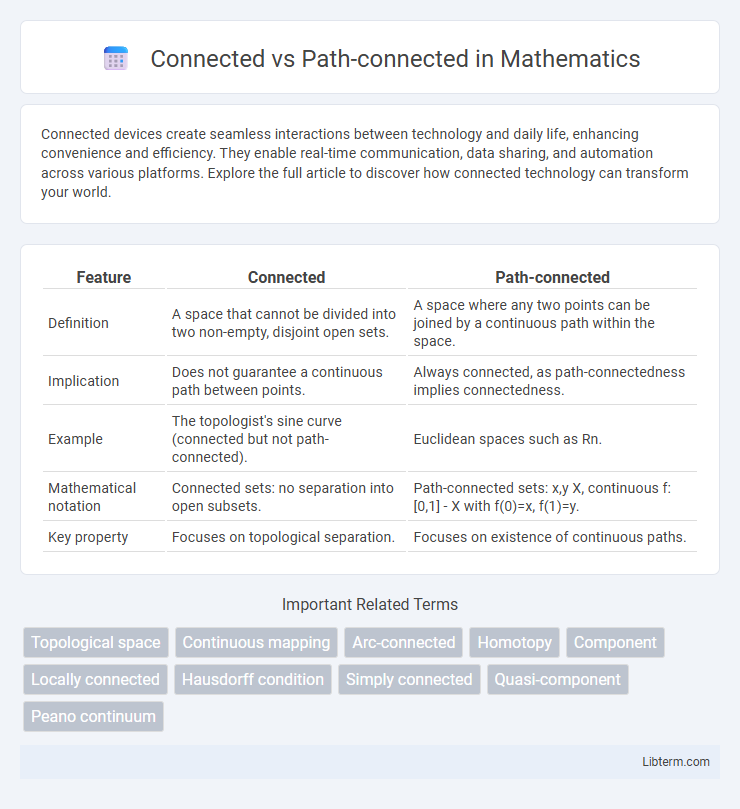Connected devices create seamless interactions between technology and daily life, enhancing convenience and efficiency. They enable real-time communication, data sharing, and automation across various platforms. Explore the full article to discover how connected technology can transform your world.
Table of Comparison
| Feature | Connected | Path-connected |
|---|---|---|
| Definition | A space that cannot be divided into two non-empty, disjoint open sets. | A space where any two points can be joined by a continuous path within the space. |
| Implication | Does not guarantee a continuous path between points. | Always connected, as path-connectedness implies connectedness. |
| Example | The topologist's sine curve (connected but not path-connected). | Euclidean spaces such as Rn. |
| Mathematical notation | Connected sets: no separation into open subsets. | Path-connected sets: x,y X, continuous f: [0,1] - X with f(0)=x, f(1)=y. |
| Key property | Focuses on topological separation. | Focuses on existence of continuous paths. |
Introduction to Connected and Path-Connected Spaces
Connected spaces are topological spaces that cannot be divided into two disjoint nonempty open subsets, ensuring there is no separation within the space. Path-connected spaces strengthen this concept by requiring that any two points can be joined by a continuous path lying entirely within the space, implying connectedness but not vice versa. These concepts are fundamental in topology, with path-connectedness often providing more intuitive geometric insights while connectedness serves as a broader classification of spaces.
Defining Connectedness in Topology
Connectedness in topology means a space cannot be divided into two nonempty, disjoint open sets, ensuring the space is in one piece. Path-connectedness is a stronger condition requiring any two points in the space to be joined by a continuous path within the space. While every path-connected space is connected, the converse is not always true, highlighting distinct levels of connectivity in topological spaces.
Understanding Path-Connectedness
Path-connectedness refers to a stronger form of connectivity in topology where any two points in a space can be joined by a continuous path within that space. Unlike general connectedness, which only requires the space not to be split into two disjoint nonempty open sets, path-connected spaces guarantee explicit routes between points, emphasizing the role of continuous mappings from the unit interval. Understanding path-connectedness is crucial for analyzing spaces where the existence of continuous paths implies topological properties relevant in geometric and analytical contexts.
Key Differences: Connected vs Path-Connected
Connected spaces contain no separation into two disjoint nonempty open sets, while path-connected spaces ensure any two points can be joined by a continuous path within the space. Path-connectedness implies connectedness, but the converse is not always true; some connected spaces lack paths linking all points. This distinction is crucial in topology for understanding space structure, as path-connectedness is stronger and enables homotopy and continuous deformation analyses.
Examples of Connected but Not Path-Connected Spaces
The topologist's sine curve is a classic example of a space that is connected but not path-connected, as it consists of the graph of sin(1/x) for x in (0,1] together with the vertical segment at x=0, yet no continuous path links these parts. Another example is the Knaster-Kuratowski fan, which is a connected compact subset of the plane without path-connectedness in certain regions. These examples illustrate that connectedness does not imply path-connectedness, highlighting differences between these two topological properties.
Examples of Path-Connected Spaces
Path-connected spaces include familiar examples such as Euclidean spaces \(\mathbb{R}^n\), where any two points can be joined by a continuous path like a straight line segment. The unit circle \(S^1\) is path-connected since an arc along the circle provides a continuous path between any two points. In contrast, spaces like the topologist's sine curve are connected but not path-connected, highlighting the stronger requirement in path-connectedness.
The Importance of Connectedness in Topology
Connectedness in topology ensures a space cannot be divided into two disjoint nonempty open sets, while path-connectedness guarantees any two points in the space can be joined by a continuous path. The distinction between these concepts is crucial for understanding the structure and properties of topological spaces, with path-connectedness implying connectedness but not vice versa. Recognizing when a space is merely connected or also path-connected influences the analysis of continuity, homotopy, and compactness in advanced mathematical contexts.
The Role of Path-Connectedness in Mathematical Analysis
Path-connectedness plays a crucial role in mathematical analysis by ensuring that any two points within a space can be joined by a continuous path, which facilitates the study of continuous functions and topological properties. In contrast to mere connectedness, path-connectedness provides stronger structural insights, allowing for the application of techniques such as homotopy and the construction of continuous deformations. This property is fundamental in studying spaces like manifolds, where path-connectedness guarantees the feasibility of defining integral curves and analyzing differential equations within the space.
Visualizing Connected and Path-Connected Spaces
Visualizing connected spaces often involves illustrating a single piece without any breaks or separations, representing a set that cannot be split into two disjoint nonempty open subsets. Path-connected spaces are depicted by showing continuous paths or curves between any two points within the space, emphasizing the existence of a continuous map from the interval [0,1] into the space linking these points. Diagrams of path-connected spaces highlight the stronger condition where every pair of points can be joined by such paths, whereas connectedness alone does not guarantee this property.
Summary: When Does Connectedness Imply Path-Connectedness?
Connectedness implies path-connectedness in certain topological spaces, such as locally path-connected spaces, where every point has a path-connected neighborhood. In these spaces, any connected set is necessarily path-connected, meaning that any two points can be joined by a continuous path within the set. However, connectedness alone does not guarantee path-connectedness in general, as some connected sets may lack paths joining all pairs of points.
Connected Infographic

 libterm.com
libterm.com